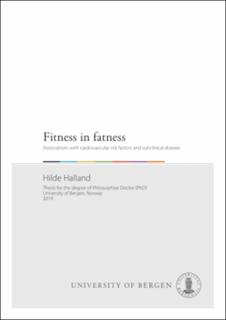| dc.contributor.author | Halland, Hilde | en_US |
| dc.date.accessioned | 2020-01-27T07:56:11Z | |
| dc.date.available | 2020-01-27T07:56:11Z | |
| dc.date.issued | 2019-05-24 | |
| dc.date.submitted | 2019-05-01T13:19:14.552Z | |
| dc.identifier | container/34/63/1c/2d/34631c2d-8a5c-4192-bee3-3113d8e1a282 | |
| dc.identifier.isbn | 9788230856536 | en_US |
| dc.identifier.isbn | 9788230857236 | en_US |
| dc.identifier.uri | https://hdl.handle.net/1956/21346 | |
| dc.description.abstract | Background: Fitness may influence cardiovascular (CV) health in obesity. We explored the impact of fitness on CV risk factors and prevalent subclinical CV disease in overweight and obese women and men without known CV disease. Materials and methods: Clinical and echocardiographic data from the FAT associated CardiOvasculaR dysfunction (FATCOR) study was used for analyses of CV risk factors and subclinical CV disease in relation to fitness. Fitness was determined by sex- and age-adjusted peak oxygen uptake on a maximal treadmill test. Results: Hypertension, metabolic syndrome and diabetes were highly and equally prevalent in fit and unfit groups (all p>0.05) (Study 1). In >40% of cases, prevalent hypertension and diabetes were diagnosed in-study. Being fit was characterized by lower waist circumference, non-obesity, non-smoking and higher muscle mass (all p<0.05). Women had more subclinical cardiac disease (77% vs. 62%) and left atrial (LA) dilatation (74% vs. 56%) than men, while men had more abnormal left ventricular (LV) geometry (30% vs. 21%, all p<0.05) (Study 2). Female sex more than doubled the risk of prevalent subclinical cardiac disease (95% confidence interval [CI] 1.48-3.22) and LA dilatation (95% CI 1.67-3.49), while male sex doubled the risk of abnormal LV geometry (95% CI 1.30-3.01) (all p<0.05). Fitness was not associated with prevalent subclinical CV disease (p>0.05). Mean global longitudinal strain (GLS) was similar between fit and unfit groups within overweight and obese groups (both p>0.05), while low GLS was more prevalent in the unfit vs. the fit obese group (30% vs. 10%, p<0.05) (Study 3). In obesity, but not overweight, fitness was associated with higher GLS (more negative value) (odds ratio 0.87 [95% CI 0.79-0.99, p<0.05), independent of confounders. Conclusion: The prevalences of major CV risk factors and subclinical cardiac disease were high and uninfluenced by fitness. Despite this, fitness in obesity was associated with improved myocardial function. Our findings indicate that women are at particular risk of subclinical cardiac disease, and that fitness alone cannot compensate for the harmful effects of increased body mass index. Furthermore, our results demonstrate the benefit of a thorough assessment of CV risk in such subjects. | en_US |
| dc.language.iso | eng | eng |
| dc.publisher | The University of Bergen | eng |
| dc.relation.haspart | Paper I: Halland H, Lønnebakken MT, Saeed S, Midtbø H, Cramariuc D, Gerdts E. Does fitness improve the cardiovascular risk profile in obese subjects? Nutr Metab Cardiovasc Dis. 2017;27:518-24. The article is available in the main thesis. The article is also available at: <a href="https://doi.org/10.1016/j.numecd.2017.04.006" target="blank">https://doi.org/10.1016/j.numecd.2017.04.006</a>. | en_US |
| dc.relation.haspart | Paper II: Halland H, Lønnebakken MT, Pristaj N, Saeed S, Midtbø H, Einarsen E, Gerdts E. Sex differences in subclinical cardiac disease in overweight and obesity (the FATCOR study). Nutr Metab Cardiovasc Dis. 2018;28:1054-60. The article is available in the main thesis. The article is also available at: <a href="https://doi.org/10.1016/j.numecd.2018.06.014" target="blank">https://doi.org/10.1016/j.numecd.2018.06.014</a>. | en_US |
| dc.relation.haspart | Paper III: Halland H, Matre K, Midtbø H, Saaed S, Pristaj N, Einarsen E, Lønnebakken MT, Gerdts E. Effect of fitness on left ventricular systolic myocardial function in overweight and obesity (the FATCOR study). Published as: Effect of fitness on cardiac structure and function in overweight and obesity (the FATCOR study). Nutr Metab Cardiovasc Dis. 2019;29(7):710-717. The article is not available in BORA. The article is available at: <a href="https://doi.org/10.1016/j.numecd.2019.03.012" target="blank">https://doi.org/10.1016/j.numecd.2019.03.012</a>. | en_US |
| dc.rights | In copyright | eng |
| dc.rights.uri | http://rightsstatements.org/page/InC/1.0/ | eng |
| dc.title | Fitness in fatness : Associations with cardiovascular risk factors and subclinical disease | en_US |
| dc.type | Doctoral thesis | |
| dc.date.updated | 2019-05-01T13:19:14.552Z | |
| dc.rights.holder | Copyright the Author. All rights reserved | |
| dc.identifier.cristin | 1758615 | |
| fs.unitcode | 13-25-0 | |
